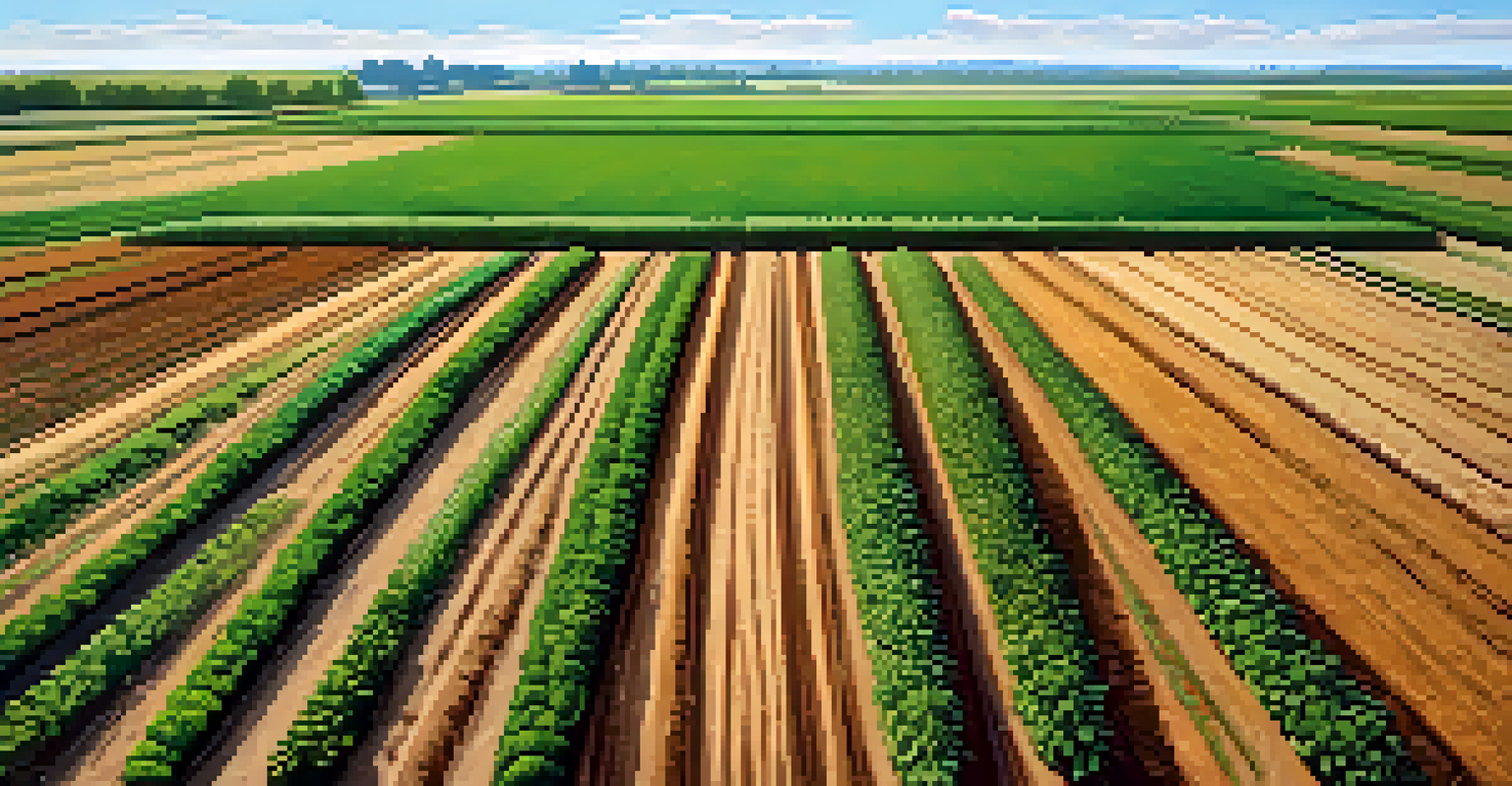Soil Health: Its Role in Plant Water Conservation Strategies

Understanding Soil Health and Its Importance
Soil health refers to the condition of soil and its ability to support plant life. Healthy soil is rich in organic matter, nutrients, and microorganisms, all of which play a vital role in plant growth. When soil is healthy, it can retain moisture more effectively, reducing the need for frequent watering. This is crucial for sustainable agriculture, especially in areas prone to drought.
The health of our soil is the foundation of our food, water, and environment.
To put it simply, think of soil health as the foundation of a house. Just as a sturdy foundation supports a home, healthy soil provides the necessary structure for plants to thrive. When the soil is in good condition, it not only supports plants but also helps in regulating water effectively. This means that plants can access the moisture they need without excessive waste.
Furthermore, healthy soil can improve water infiltration, allowing rainwater to soak in rather than run off. This capacity to absorb water is essential for maintaining the moisture levels that plants need to flourish. In essence, prioritizing soil health is like giving plants a reliable reservoir of water to draw from, making them more resilient to dry spells.
The Role of Organic Matter in Soil Health
Organic matter is the heart of healthy soil, composed of decomposed plant and animal materials. When we boost organic matter in soil, we enhance its ability to hold water, which is crucial for plant survival. For example, adding compost or mulch helps create a sponge-like environment that captures and retains moisture, ensuring plants have a steady supply.

Moreover, organic matter improves soil structure, allowing for better air circulation and root development. Imagine a sponge: when it's full of water, it expands and becomes soft, making it easier for roots to penetrate. Similarly, when soil is rich in organic matter, it becomes more porous, promoting healthier plant growth and better water retention.
Soil Health Supports Plant Growth
Healthy soil, rich in organic matter and microorganisms, enhances plant growth by improving water retention and nutrient availability.
Additionally, organic matter supports a diverse ecosystem of microorganisms that contribute to nutrient cycling. These tiny helpers break down organic materials, releasing essential nutrients that plants need to thrive. This means that by enhancing soil health through organic matter, we not only conserve water but also create a thriving environment for plants.
Soil Structure: How It Affects Water Retention
Soil structure refers to the arrangement of soil particles and the spaces between them. Good soil structure is crucial for water retention, as it influences how water moves through the soil. Well-structured soil can create small pockets of air and water, allowing plants to access moisture more efficiently.
Soil is a living system, and when we nourish it, it nourishes us back.
Think of soil structure like a network of highways. Just as a well-maintained highway system allows for smooth traffic flow, well-structured soil facilitates water movement. When soil is compacted or poorly structured, water can either run off or become trapped, making it difficult for plants to reach it.
Furthermore, improving soil structure can be achieved through practices like crop rotation and reduced tillage. These methods encourage the development of a more stable soil structure, which in turn enhances water retention. By focusing on soil structure, farmers and gardeners can create an environment that optimizes water conservation.
The Impact of Soil Microorganisms on Water Conservation
Microorganisms play a vital role in maintaining soil health, and their activities significantly influence water conservation. Beneficial microbes can help decompose organic matter, which aids in nutrient release and improves the soil's water-holding capacity. This means that a healthy community of microorganisms can create a more resilient ecosystem for plants.
Consider these microorganisms as the unsung heroes of the soil. They work tirelessly behind the scenes, breaking down complex materials into simpler forms that plants can easily absorb. This not only supports plant health but also enhances the soil's ability to retain moisture, ensuring plants have what they need during dry periods.
Organic Matter Enhances Water Retention
Incorporating organic matter like compost creates a sponge-like environment in soil, which helps capture and hold moisture for plants.
Moreover, some microorganisms can form symbiotic relationships with plant roots, helping them absorb water and nutrients more efficiently. This partnership is essential for maximizing water use, especially in challenging environments. By fostering a diverse array of soil microorganisms, we can significantly improve water conservation strategies in agriculture.
Water Management Practices That Support Soil Health
Implementing effective water management practices is key to supporting soil health and enhancing water conservation. Techniques like rainwater harvesting, drip irrigation, and mulching can help capture and retain moisture in the soil. These practices not only reduce water waste but also ensure that plants receive adequate hydration.
For instance, using drip irrigation allows water to be delivered directly to the plant roots, minimizing evaporation and runoff. This targeted approach complements the natural water retention capabilities of healthy soil, leading to more efficient water use. Additionally, applying mulch can reduce soil temperature and prevent moisture loss, creating an ideal environment for plant growth.
By integrating these water management practices into farming and gardening routines, we can create a synergistic relationship between water conservation and soil health. This holistic approach not only benefits plants but also promotes a sustainable agricultural system in the long run.
The Benefits of Cover Crops for Soil and Water Health
Cover crops are a fantastic tool for enhancing soil health and improving water conservation. These plants, grown during off-seasons, help protect the soil from erosion, improve its structure, and increase organic matter. By planting cover crops, farmers can create a living mulch that retains moisture and reduces the need for irrigation.
Think of cover crops as a protective blanket for the soil. They shield it from harsh weather conditions, while their roots help break up compacted soil layers, allowing water to penetrate more easily. This not only enhances water retention but also fosters a thriving ecosystem for beneficial microorganisms.
Cover Crops Boost Soil and Water Health
Planting cover crops protects soil, improves its structure, and retains moisture, leading to better water conservation and soil health.
Moreover, cover crops can prevent nutrient leaching, which occurs when excess rainfall washes away essential nutrients from the soil. By keeping these nutrients in place, cover crops support healthy plant growth and contribute to a more sustainable farming system. Incorporating cover crops into agricultural practices is a win-win for both soil health and water conservation.
Conclusion: Embracing Soil Health for a Sustainable Future
In conclusion, prioritizing soil health is essential for effective plant water conservation strategies. Healthy soil not only supports plant growth but also plays a crucial role in retaining moisture, ensuring that plants have the resources they need. By understanding the various factors that contribute to soil health, such as organic matter, structure, and microorganisms, we can create more resilient ecosystems.
Furthermore, implementing practices like cover cropping, effective water management, and enhancing soil structure will lead to sustainable agricultural practices. These strategies not only benefit the environment but also contribute to food security, especially in regions facing water scarcity. By embracing soil health, we pave the way for a more sustainable future.

Ultimately, the connection between soil health and water conservation is a powerful reminder of nature's interconnectedness. As we work to improve soil health, we take significant strides toward ensuring that both plants and the planet thrive for generations to come.